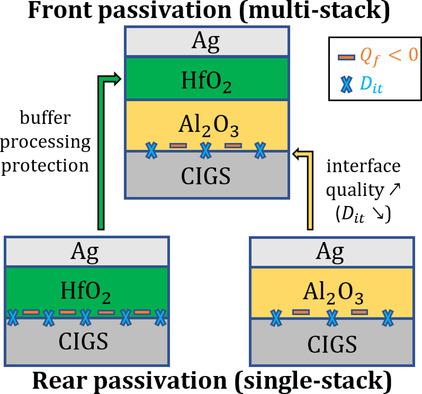当前位置:
X-MOL 学术
›
Phys. Status Solidi A
›
论文详情
Our official English website, www.x-mol.net, welcomes your
feedback! (Note: you will need to create a separate account there.)
Comparative Study of Al2O3 and HfO2 for Surface Passivation of Cu(In,Ga)Se2 Thin Films: An Innovative Al2O3/HfO2 Multistack Design
Physica Status Solidi (A) - Applications and Materials Science Pub Date : 2021-05-13 , DOI: 10.1002/pssa.202100073 Romain Scaffidi 1, 2, 3 , Dilara G. Buldu 2, 3, 4 , Guy Brammertz 2, 3, 4 , Jessica de Wild 2, 3, 4 , Thierry Kohl 2, 3, 4 , Gizem Birant 2, 3, 4 , Marc Meuris 2, 3, 4 , Jef Poortmans 3, 4, 5, 6 , Denis Flandre 1 , Bart Vermang 2, 3, 4
Physica Status Solidi (A) - Applications and Materials Science Pub Date : 2021-05-13 , DOI: 10.1002/pssa.202100073 Romain Scaffidi 1, 2, 3 , Dilara G. Buldu 2, 3, 4 , Guy Brammertz 2, 3, 4 , Jessica de Wild 2, 3, 4 , Thierry Kohl 2, 3, 4 , Gizem Birant 2, 3, 4 , Marc Meuris 2, 3, 4 , Jef Poortmans 3, 4, 5, 6 , Denis Flandre 1 , Bart Vermang 2, 3, 4
Affiliation

|
In Cu(In,Ga)Se2 (CIGS) thin-film solar cells, interface recombination is one of the most important limiting factors with respect to device performance. Herein, metal–insulator–semiconductor samples are used to investigate and compare the passivation effects of Al2O3 and HfO2 at the interface with CIGS. Capacitance–voltage–frequency measurements allow to qualitatively and quantitatively assess the existence of high negative charge density (Q
f ≈ −1012 cm−2) and low interface-trap density (D
it ≈ 1011 cm−2 eV−1). At the rear interface of CIGS solar cells, these, respectively, induce field-effect and chemical passivation. A trade-off is highlighted between stronger field-effect for HfO2 and lower interface-trap density for Al2O3. This motivates the usage of Al2O3 to induce chemical passivation at the front interface of CIGS solar cells but raises the issue of its processing compatibility with the buffer layer. Therefore, an innovative Al2O3/HfO2 multistack design is proposed and investigated for the first time. Effective chemical passivation is similarly demonstrated for this novel design, suggesting potential decrease in recombination rate at the front interface in CIGS solar cells and increased efficiency. 300 °C annealing in N2 environment enable to enhance passivation effectiveness by reducing D
it while surface cleaning may reveal useful for alternative CIGS processing methods.
中文翻译:

Al2O3 和 HfO2 用于 Cu(In,Ga)Se2 薄膜表面钝化的比较研究:一种创新的 Al2O3/HfO2 多层设计
在 Cu(In,Ga)Se 2 (CIGS) 薄膜太阳能电池中,界面复合是影响器件性能的最重要的限制因素之一。在此,金属-绝缘体-半导体样品用于研究和比较 Al 2 O 3和 HfO 2在与 CIGS 界面处的钝化效果。电容-电压-频率测量允许定性和定量评估高负电荷密度(Q f ≈ -10 12 cm -2)和低界面陷阱密度(D it ≈ 10 11 cm -2 eV -1)的存在)。在 CIGS 太阳能电池的后界面,这些分别引起场效应和化学钝化。HfO 2更强的场效应和Al 2 O 3更低的界面陷阱密度之间的权衡被强调。这促使使用 Al 2 O 3在 CIGS 太阳能电池的前界面诱导化学钝化,但引发了其与缓冲层的加工兼容性问题。因此,创新的 Al 2 O 3 /HfO 2首次提出并研究了多堆栈设计。这种新颖的设计同样证明了有效的化学钝化,表明 CIGS 太阳能电池前界面的复合率可能降低,效率提高。在 N 2环境中进行300 °C 退火能够通过降低D it来提高钝化效果,而表面清洁可能显示出对替代 CIGS 加工方法有用。
更新日期:2021-07-22
中文翻译:

Al2O3 和 HfO2 用于 Cu(In,Ga)Se2 薄膜表面钝化的比较研究:一种创新的 Al2O3/HfO2 多层设计
在 Cu(In,Ga)Se 2 (CIGS) 薄膜太阳能电池中,界面复合是影响器件性能的最重要的限制因素之一。在此,金属-绝缘体-半导体样品用于研究和比较 Al 2 O 3和 HfO 2在与 CIGS 界面处的钝化效果。电容-电压-频率测量允许定性和定量评估高负电荷密度(Q f ≈ -10 12 cm -2)和低界面陷阱密度(D it ≈ 10 11 cm -2 eV -1)的存在)。在 CIGS 太阳能电池的后界面,这些分别引起场效应和化学钝化。HfO 2更强的场效应和Al 2 O 3更低的界面陷阱密度之间的权衡被强调。这促使使用 Al 2 O 3在 CIGS 太阳能电池的前界面诱导化学钝化,但引发了其与缓冲层的加工兼容性问题。因此,创新的 Al 2 O 3 /HfO 2首次提出并研究了多堆栈设计。这种新颖的设计同样证明了有效的化学钝化,表明 CIGS 太阳能电池前界面的复合率可能降低,效率提高。在 N 2环境中进行300 °C 退火能够通过降低D it来提高钝化效果,而表面清洁可能显示出对替代 CIGS 加工方法有用。











































 京公网安备 11010802027423号
京公网安备 11010802027423号